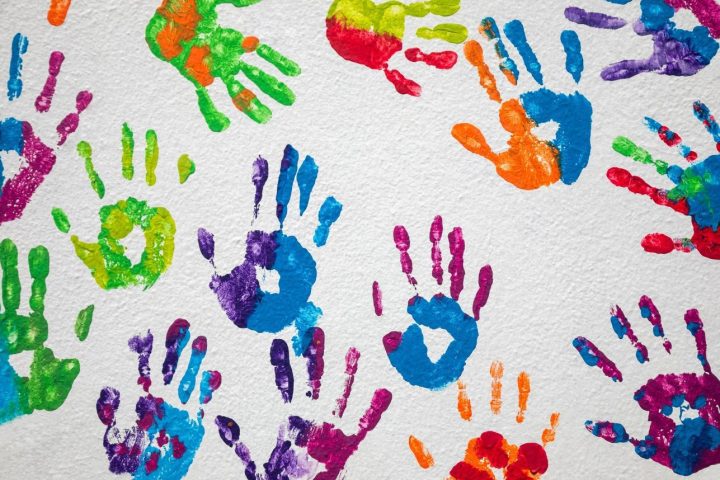“Told Me I Was Fit to Wear the Crown”: Youth Healing and Homeplace Literacies as Public Pedagogy

“We are all family. I’m here to keep you safe, and you’re here to keep me safe. Correct? We keep our love. We love each other ‘cause ain’t nobody else gonna love us but us. Right? We keep us radiant, and we keep us magical.”— Catlyn Savado
With a megaphone in hand, Catlyn Savado’s words captivated the crowd of students surrounding her. Moments earlier, she and 500 other Chicago Public School students walked out of her public-school building to protest their learning conditions. A freshman in high school—two years into a global pandemic that disproportionately impacts Black and brown communities—Catlyn and her peers finally had enough of the persistent systemic failures that compromised their education and humanity.
Seemingly overnight, Catlyn brought nearly twenty Chicago Public Schools together for a walkout that demonstrated the ways youth continue to both shoulder the burden and rise above ongoing government failures in a system that continually fails to protect them. But the momentum has manifested itself for far longer. Consistently, systems of oppression undercut marginalized youth across the country and fight against their genius and innovative pedagogies. Their brilliance emerges, however, while also illuminating a failed state that disproportionately tasks marginalized youth with martyring away their childhoods to validate their humanity. Yet, today’s youth’s public pedagogies—the swiftness, strength, and impact of their activism—center languages and expressions of their geniuses, healing, and growth. More recently, with the convergence of a mental health crisis and pandemic, youth have, as Dr. Bettina Love (2013) found, gone “underground” together— organizing on social media and emerging with gusto to produce the reckoning and wakeup call that failed institutions need. In doing so, their public pedagogies—the social media platforms and communities they’ve formed to sustain their movements—have created the homeplaces they need to thrive, sustain, and make sense of the world.
With this reality, homeplace emerges as a space of healing and resistance (Kelly, 2020). In Homeplace, bell hooks defines these spaces as “fragile and tenuous…[with] a radical dimension, one’s homeplace was the one site where one could freely construct the issue of humanization, where one could resist” (1992). hooks goes on to explore how Black women use homeplaces as both resistance and healing, spaces where “all Black people could strive to be subjects, not objects, where we could be affirmed in our minds and hearts despite poverty, hardship, and deprivation, where we could restore to ourselves the dignity denied us on the outside in the public world (Homeplace, 1992).” In our ever-evolving, politically polarized world, homeplaces emerge as conduits of healing and liberation for students tethered to oppressive institutions (Kelly, 2020; Player et. al, 2021). Though hooks describes these spaces living outside of the contexts that reinforce the oppression, Drs. Bettina Love (2013) and Chris Emdin (2018) use hip hop; Dr. Yolanda Sealey-Ruiz (2020) uses poetry and Archeology of the Self (2021) to take up the creation of homeplaces within oppressive spaces.
Further, Dr. Jennifer Pastor et al. (2007) explore the resistance strategies specifically used by Black and Latinx urban girls in response to oppressive forces. As students develop critical consciousness, homeplaces become broadly defined and inclusive of comforting and safe spaces in institutions such as schools (Pastor et al., p. 75). They become, as Dr. Shawn Ginwright proposes, both limitless and holistic “involving culture, spirituality, civic action and collective healing” (2018).
Like the students in CPS and across the country, foster youth also continually shoulder the burdens of numerous systems that fail them. Since the COVID-19 pandemic, school closures have further exacerbated conditions for foster youth and hindered their learning. Access to technology, housing and food security, community and caregiver support are just some of the obstacles that the COVID-19 pandemic has intensified for foster youth. This narrative isn’t new; long has America reckoned with how it treats its children. “So much of America’s tragic and costly failure to care for all its children,” Marian Edelman avers, “stems from our tendency to distinguish between our own children and other people’s children—as if justice were divisible.”
A recent Field Center study, “‘I Was Already Broke: Now I Feel Broken:’ Amplifying the Voices of Youth Experiencing & Aged Out of Foster Care During COVID 19 & Its Impact on Mental Health,” highlights the ways foster youth specifically counteract America’s failures with healing and homeplace literacies. In doing so, these youth carve public pedagogies that become knowledges which push institutions toward courage and change. Continually, the foster youth in this study went “underground,” turning to healing social medias, books, movies, and digital discourses to make sense of their world. “When I’m having a bad day or mental health problems,” Participant 27 says, “I continuously go back to my favorite shows or my favorite book.” In the absence of in-person schooling communities, foster youth turned to people like motivational social media personalities and authors Tabitha Brown and Brené Brown, and athletes Simone Biles and Naomi Osaka to understand, find solidarity, and lean into conversations that exposed the nuances of social oppression and mental health challenges dominating their worlds. Participant 16 details the impact of the podcast “On Purpose” with Jay Shetty—who strives to make wisdom go viral through insightful and fascinating conversations with people from all walks of life—as “amazing” and “my absolute favorite podcast.” These foster youth—some entirely absent of stable community connections—brilliantly turned outward to build their unique networks of informal mentorship that healed, educated, motivated, and fed their souls. “I got on Facebook and TikTok, and that kept me busy,” Participant 7 underscores, “when I was TikToking to people, I didn’t feel lonely.”
Finding home in digital spaces and leaning on the strength of each other, these foster youth emerged—both from the foster care system that failed them and into the world—with healing literacies, learned from cultivated digital communities, to provide new and innovative takes that reimagine the foster care system—specifically, the supports for those who age out. The importance of support is evident. “I realize when I had someone to talk to,” Participant 28 said, “it didn’t feel like I had so much on my shoulders by myself. It didn’t feel like I had to do so much alone.” Yet, so many youth spoke concretely about much-needed structural changes. “I always really wanted to have a community of other foster youth or former foster youth and felt like it was impossible to find,” noted Participant 10. Youth repeatedly voiced concerns about providing better training for caseworkers, more secure housing placements, and increased mentoring and support. “It was like they didn’t want me to be happy,” Participant 21 expressed, and from Participant 7, “If DHS could understand where the child came from, they would understand why the child acts the way they do.”
So many of these youth took matters into their own hands, piecing together what they had to create digital support networks that validated and amplified their voices. Seven of the 26 foster youth interviewed spoke about feeling left out of decisions and spaces that influenced their conditions. From feeling “not prioritized in policies” (10) to proposing that “People should encourage teenagers. Teenagers are either afraid to speak up or embarrassed of how they feel” (17). On the foster care system, Participant 4 powerfully remarks,
The youth voice got lost in this whole process, lost in the talk for sure…when the pandemic started, [youth] weren’t being given the votes, the voice to make decisions and to just bring up concerns. It was all made for us by the experts, so to speak.
Feeling left out from decisions that impact their lives, many foster youth demonstrated quiet activism, drawing on their healing and homeplace literacies to pay it forward in spaces where their voices had value and could connect with the next generation. One participant demonstrated a desire to take an activist stance by going to school for social work “just to give back” (12). Two participants speak about volunteer work with foster youth that centers art as homeplace and activism by “helping with their writing and do[ing] like a little virtual open mic at the end of each month for them” and participating in an organization “to help youth in the community build [murals]” (3). Further, these youth turned to digital platforms to build homeplace where it was absent—creating Facebook groups to connect to other foster youth while also advocating for the need to provide a more sophisticated and centralized “community dashboard kind of thing where young people could just share thoughts, ideas, feelings” (4). All while echoing the necessity to understand, listen, and prioritize youth in decision making and reform.
Which brings us to a crossroads—a reckoning with ourselves and our youth—generational knowledges of the old meeting the new and unfamiliar. It’s a changing of the guard and one that we should wisely accept with loving, open arms that facilitates the conditions for marginalized youth to harness their liberation. Because though this moment is heavy, though this time is uncertain for many, it is essential that our youth are told they’re fit to wear the crown. Because they believe it. Amid this all, they believe in the strength of their love, radiance, and magic. COVID-19 brought them here, and our youth have worked, watched, and waited patiently—hoping that we will do what’s right with the opportunities this pandemic has bestowed on us. But we haven’t, so they have. They’ve emerged from the underground off the strength of each other to correct our course. They’ve drawn on their digital literacies and communities to create public pedagogies that center healing and home to make sense of our world that demands flux leadership and pedagogy (Ravitch, 2020). They’ve used this pandemic portal—a place of newness and opportunity—to gift to us their vision filled with vibrancy and life. Let us go forward, with bravery and compassion, and believe in their vision. It is crucial that we believe. Because they do. They believe that they are fit to wear the crown, and, as luminary Billie Holiday reminds us, it’s imperative that we do not let them down.
References
Emdin, C., & Adjapong, E. S. (Eds.). (2018). # HipHopEd: The Compilation on Hip-Hop Education: Volume 1: Hip-Hop as Education, Philosophy, and Practice. BRILL.
Ginwright, S. (2018). “The Future of Healing: Shifting from Trauma Informed Care to Healing Centered Engagement.” Medium.
hooks, b. (1992). “Homeplace.” Yearning: Race, Gender, and Cultural Politics. Hypatia, 7(2).
Kelly, L. L. (2020). “I Love Us for Real”: Exploring Homeplace as a Site of Healing and Resistance for Black Girls in Schools. Equity & Excellence in Education, 53(4), 449-464.
Lindsey, T. B. (2015). Let Me Blow Your Mind: Hip Hop Feminist Futures in Theory and Praxis. Urban Education, 50(1), 52–77.
Love, B. L., & Tosolt, B. (2013). Go underground or in your face: Queer students’ negotiation of all-girls Catholic schools. Journal of LGBT Youth, 10(3), 186-207.
Mentor, M., & Sealey-Ruiz, Y. (2021). Doing the Deep Work of Antiracist Pedagogy: Toward Self-Excavation for Equitable Classroom Teaching. Language Arts, 99(1), 19-24.
Pastor, J., McCormick, J., Fine, M., Andolsen, R. C., Friedman, N. C., Richardson, N. C., …Tavarez, M. C. (2007). “Makin’ Homes: An Urban Girl Thing.” In B. J. R. Leadbeater & N. Way (Eds.), Urban girls: Resisting stereotypes, creating identities (pp. 75–96). New York University Press.
Player, G. D., Ybarra, M. G., Brochin, C., Brown, R. N., Butler, T. T., Cervantes-Soon, C., … & Sealey-Ruiz, Y. (2021). “We Are Our Only Way Forward”: Dialogic Re-imaginings and the Cultivation of Homeplace for Girls, Women, and Femmes of Color. Urban Education, 00420859211003931.
Ravitch, S. M. (2020). Flux Leadership: Leading for Justice and Peace in & Beyond COVID-19. Penn GSE Perspectives on Urban Education, 18(1), n1.
Sealey-Ruiz, Y. (2020). Love from the Vortex & Other Poems. Kaleidoscope Vibrations, LLC.
Warren, H. and Dubin A. (1973). “You Let Me Down.” B. Holiday. The Billie Holiday Story, Vol. 2.


